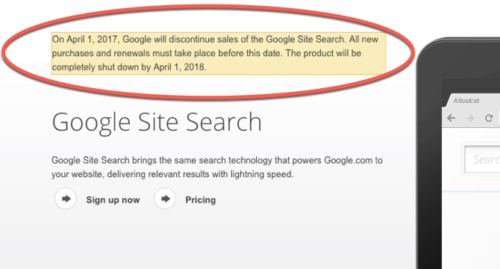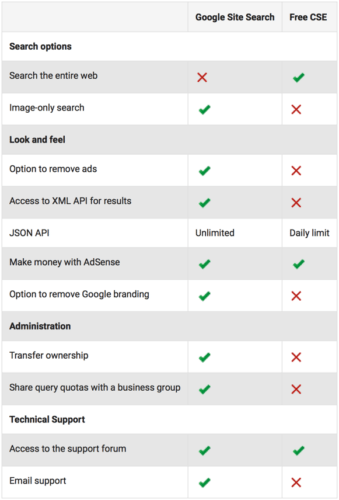 Google recently began the process of shutting down its Site Search service, leaving businesses everywhere wondering what to do next. If you haven’t yet heard the news about Google Site Search, it more than likely still affects you.
Google recently began the process of shutting down its Site Search service, leaving businesses everywhere wondering what to do next. If you haven’t yet heard the news about Google Site Search, it more than likely still affects you.
Google Site Search is the search bar on your website that allows visitors to look directly for products, services or other content they can’t find directly through your site’s navigation.
For SMBs especially, losing this service without replacing it may lead to losing website traffic, potential customers and data that helps optimize the lead generation capabilities of your website. We’ve put together a series of 3 blogs to help you easily understand what the end of Google Site Search means for your business, what your alternatives are, and how you can turn this into a marketing opportunity.
The Phase Out Timeline
Google announced on February 21st, via email to all Site Search customers, that it will be phasing out its Google Site Search product. On April 1st, 2017, Google discontinued all subscription sales of Site Search, marking the first phase of the service shutdown.
If your subscription ends between April 1st and June 30th, Google is granting a free 3-month extension of Site Search services to give you more time to prepare for the shutdown. Other than that, you’ll have to find an alternative.
On April 1st, 2018, Google Site Search will be shutdown completely and all sites still using Site Search will be automatically downgraded to the new service, Google Custom Search Engine (CSE).
That last part is important. Even Google describes the switch to the new service as a “downgrade.” There are key drawbacks to the new CSE service that are prompting businesses everywhere to evaluate other options and make plans to avoid being hurt by the switch.
The New Google Custom Search Engine
Google CSE has one main advantage: it’s free. But that friendly price tag comes with important stipulations that can undermine your digital marketing efforts.
The main problem with Google CSE is that it allows ads to show on search results within your website, with no option to remove them. This means website visitors searching for products and services on your website could go elsewhere, without making a purchase or getting in touch with you.
Even worse, it’s very likely these ads will be served by your competitors through AdWords. If people are consistently searching for “nuts and bolts” on your website, your competitors stand to gain a lot of good traffic by serving ads for those searches within your website.
Someone who’s searching for specific products and services on your site is likely considering a purchase, or taking the next step towards a purchase. At that point, your marketing efforts have done most of the heavy lifting in terms of getting a sale. If your competitors can steal traffic at this stage of the buyer’s journey, it completely undermines the efforts of the rest of your marketing initiatives.
There are some other drawbacks to CSE, including the fact that there’s less technical support available and it’s only free for up to 100 searches per day, but mainly it’s the fact that CSE supports ads that makes it a bad solution for SMBs.
It’s worth noting the sole exception to this is for non-profits, who can remove ads if they prove 501-(c)(3) status.
For your convenience, here is a full list of the differences between Google Site Search and Google Custom Search Engine:

Be Prepared for Site Search Changes on Your Site
Now you know what you’re up against. While the phase out of Google Site Search hasn’t exactly dominated headlines, it’s still important to address, especially for SMBs.
If you don’t want ads to be served within your website, you will need to invest some time and resources to replace Google Site Search.
Don’t miss our next blog focusing on the different alternatives available.
